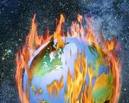
Global Warming and Gender Equity

Getting hot in here....
On Monday, the United Nations convened a High Level panel on climate change in advance of the opening of the General Assembly session this week. On the same day, a group of women and men— some “high level,” some citizen advocates—gathered at a roundtable, also in New York City, to address the links between gender and a warming world. What’s gender got to do with it? Well, in most parts of the world, women and men have differentiated access to and control over resources. They also have different responsibilities, with the burden of securing daily essentials like water and fuel falling predominantly on women. When extreme weather comes, women are often more vulnerable, but they also often have knowledge of how to adapt that isn’t taken into account by society at large. Few women have been accorded key leadership positions in the global climate change debate so far—or in decision-making about what to do.
The “alternate” high level panel, led by former Norwegian Prime Minister Gro Harlem Brundtland and Mary Robinson, former President of Ireland, sought to address this, and not a moment too soon. The conveners of the panel, the Women’s Environment and Development Organization, the Council of World Women Leaders and the Heinrich Boll Foundation, agreed on a Declaration on gender and climate change that they’ve delivered to UN Secretary General Ban Ki-Moon. Brighter Green signed on to it. The full text is below. Read more about gender and climate change here. Nobel Peace Laureate Wangari Maathai was also in New York City this week, and spoke about climate change. Read more here about her talk on Wednesday night at the American Museum of Natural History. And you can also read about the UN’s own high level global warming panel here. Things are heating up. Here’s the Declaration:
The following recommendations in the area of climate change and gender equality were developed on the occasion of the UN Secretary General’s High-Level Climate Change Event and the High-Level Roundtable “How a Changing Climate Impacts Women” organized by the partners above.
- The UN Secretary-General and governments should send a strong message to this year’s UNFCCC COP-13 in Bali that gender equality is to be integrated as a cross-cutting issue in the negotiations and debates and that women’s equal participation must be ensured. Governments should draw on the innumerable global agreements that relate directly or indirectly to gender equality and climate change , as well as gender expertise within the UN system and at the national level.
- Given that women’s knowledge and participation has been critical to the survival of entire communities in disaster situations, governments should take advantage of women’s specialized skills in various aspects of their livelihood and natural resource management strategies that lend themselves to mitigation and adaptation.
- Since climate change disproportionately affects poor women, governments should analyze and identify gender-specific impacts and protection measures related to floods, droughts, heat waves, diseases, and other environmental changes and disasters. The global community should prioritize reducing the high levels of female mortality rates resulting from climate-induced disasters and livelihood changes.
- Given the vulnerability of the poor, and particularly women, to climate change, adequate funds must be allocated by Annex I countries to help these groups adapt to the impacts.
- Practical tools should be developed that allow governments and institutions to incorporate gender equality in climate change initiatives.
- Governments at national and local levels should develop strategies to enhance women’s access to and control over natural resources, in order to reduce poverty, protect environmental resources, and ensure that women and poor communities can better cope with climate change.
- Governments and institutions should enhance opportunities for education and training in climate change mitigation and adaptation. Capacity building and technology transfer measures should draw on priorities put forward by women and poor communities.
- Women’s participation in climate change related debates and planning must be enhanced by tools and procedures that augment their capacity and sensitize decision-makers to the advantages of equal participation.
- The UNFCCC should develop a gender strategy, invest in gender-specific climate change research, and establish a system for the use of gender-sensitive indicators and criteria for governments to use in national reporting to the UNFCCC Secretariat, adaptation planning, or projects under the Clean Development Mechanism (CDM).
- Market-based approaches to curbing climate change, such as the Clean Development Mechanism, should be made accessible to both women and men and ensure equitable benefits, considering that women and men do not have equal access to natural resources such as water and energy, land titles, credit, or information. In particular, the CDM should fund projects that make renewable energy technologies more available to women and meet their household needs.
- The gendered impacts of biofuels and nuclear energy as a solution to reducing greenhouse gas emissions should be assessed, in cooperation with gender experts and women’s organizations.
- Since the UNFCCC emerged from UNCED, which outlines nine major groups that are essential to sustainable development, women and all major groups should be included as official focal points in the UNFCCC.
 Brighter Green
Brighter Green



